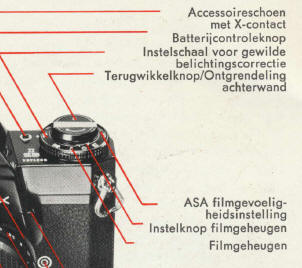
INDEX
|
Introduction -
Nomenclature
Specifications
How it works
Film loading and
winding
Setting ASA
film speed — Film type reminder dial
Exposure factor
control dial
Diaphragm setting
Compose and focus
TTL metering and
automatic shutter
Viewfinder blinds
Open-aperture or
stop-down reading
|
Depth-of-field
preview lever
Mechanical
shutter
Film loading
Camera holding
Battery insertion and check
Self-timer
Flash synchronization
Depth-of-field guide
Depth-of-field table
SMC Takumar 50mm lens
Infra-red photography
Multiple exposure -
Important notes
Guide book for Asahi Pentax system of photography
Warranty policy
|
HONEYWELL PENTAX
ESII: Your Honeywell Pentax ES II is the most exciting 35mm SLR camera on the market today, It comes equipped with a through-the-lens metering system with
focal-plane electronic shutter for automatic exposure control. The fully automatic electronic shutter operates just like an electronic computer assuring
you of
perfect exposure every time. This new electronic shutter lets you shoot automatically at any speed between 1/1000 and 8 seconds! If the exact shutter
speed should be 1/459, 1/733 or 1/952 seconds, then that's the shutter speed that will be automatically selected. Our patented memory device and electronic
shutter make it possible. There's also an exposure control dial for intentional over- or under-exposures.
The Pentax ES II
is the automatic single-lens reflex camera that works automatically without special lenses. It operates automatically with virtually all Takumar lenses, as
well as, bellows, extension tubes, and other close-up accessories. The reason is that the automation is incorporated into body itself, not into the lens. Your
Pentax ES II is equipped with a Super-Multi-Coated Takumar lens. Exclusively developed by Pentax, Super-Multi-Coated Takumar lenses reduce flare and boost
contrast to a degree far beyond what was previously possible in optical technology. Your pictures will have more detail and richer colors than is
possible with any other system at any price.
In addition to the exclusive new features of the Pentax ES II, you̓ll find many of the refinements that have established Pentax as the leading fine camera maker
in the world. The ES II retains the same traditional compactness and classic feel. It also is designed for use with the accessories from the Pentax system,
including all the Takumar lenses ranging from dynamic wide angle to powerful telephoto. The Pentax system is ready to grow with you.
The Honeywell Pentax ES II is an excellent choice in a fine camera. We wish you exciting photography in the years to come.


SPECIFICATIONS:
Type: 35mm TTL-metering SLR camera with focal-plane electronic shutter for automatic exposure control.
Film and Picture Size: 35mm film. 24mm x 36mm.
Standard Lenses: -- SMC Takumar 50mm f/l.4 and 55mm f/1.8 with fully automatic diaphragm. Distance scale: 0.45m (1.5 feet) to infinity. Filter size:
49mm. With depth-of-field scale.
 |
Shutters: TTL-metering electronic shutter for automatic exposure control + mechanical shutter for manual speed selection.
Horizontal run focal plane shutter.
Electronic shutter speeds: unlimited variation between 8 and 1/1000 sec.
Mechanical shutter: 1/60 (X), 1/125, 1/250, 1/500, 1/1000 sec. Shutter button safety lock also serves for Time exposure.
Self-timer: Built-in self-timer with interrupt function. Releases shutter in 5 - 11 sec.
Viewfinder: Eye-level pentaprism finder with Fresnel lens + microprism. 0.89x magnification with 50mm lens. Life-size magnification with
55mm lens. --1.0 dioptric. 93% viewfinder coverage. Viewfinder blinds can be closed in automatic shutter mode. Shutter speed calibration, TTL meter needle
and battery check mark in the viewfinder screen.
Focusing: -- Turn the distance scale ring until the subject image in the viewfinder comes into sharp focus. Minimum focusing distance: 0.45m (1.5
feet).
Reflex Mirror: Instant return type.
Film Advance: Ratchet type rapid wind lever. 10° pre-advance and 160° advance angle.
|
 |
Film Rewind: Rapid rewind crank. Film rewind button on base of camera body releases film from take-up spool for rewind.
Film Exposure Counter: Automatic re-set type. Wound Indicator A red disk appears in a small window alongside the shutter release
button when the shutter is wound, and blacks out when it is released.
Lens Mount: 42mm thread (Pentax-mount). Flash Synchronization FP
+ X contacts for conventional flash cord connection. X contact on hot shoe for convenient cordless flash connection.
Exposure Meter: CdS-activated TTL meter for open-diaphragm and stop-down reading. Light measurement range: EV1 -- 18 with ASA 100 film. ASA
speed scale: 20 -- 3200.
|
Exposure Factor: Control Dial -- 1X for normal exposure. 2x, 4x, 1/2X for international over- or under-exposure.
Power source: Four 1.5V silver oxide batteries (Eveready S76E or Mallory MS-76H).
Film Type: Indicator (black & white), * (color daylight),
8 (color tungsten) and EMP. (empty).
Dimension: With 50mm lens: width 143mm (5.6") x height 98mm (3.9") x thickness 93mm (3.7"). With 55mm lens: width 143mm (5.6") x height 98mm
(3.9") x thickness 90mm (3.5").
Weight: 930g (1 lb. 14 oz.) with 50mm lens. 879g (1 lb. 12oz.) with 55mm lens. 678g (1 lb. 6 oz.) without lens.
HOW IT WORKS
 |
The batteries are packed separately. Be sure to insert them into the battery housing before operating the camera.
For insertion, refer to page 20. |
|
1. Load your film and set ASA film speed.
2. Keep this at "1X" for normal exposure.
3. Pre-select f/stop.
4. Set shutter speed dial at "AUTOMATIC".
|
 |
 |
5. Keep this lever down for open-aperture exposure reading. (Lens aperture stays fully open, and stops down to pre-selected f/stop as you depress shutter
release.) Move it up for depth-of-field preview or for stop-down exposure reading. (Lens aperture actually stops down to pre-selected f/stop.)
6. TTL meter reading. Softly depress shutter button. Electric circuit is now switched on. Meter needle starts moving and indicates correct shutter speed.
|
7. Electronic memory device stores exposure reading information.
8. Depress shutter release button completely.
9. Memory device automatically releases electronic shutter.
FILM LOADING AND WINDING
 |
| l. Open the back by pulling out the rewind knob until the back cover snaps open. |
2. Place the film cassette properly into the cassette chamber, and push down the rewind
knob. Insert the film leader into the slot of the take-up spool. |
3. Advance the film by alternately turning the rapid wind lever and depressing the shutter button until both sprockets engage the film perforations
properly. Close the back by pressing it firmly. |
|

|
| 4. Wind the rapid wind lever, and confirm that the film rewind knob automatically turns counter-clockwise,
indicating that the film is properly loaded and is moving from cassette to take-up spool. Trip the shutter. |
5. The first portions of the film cannot be used for picture taking as they have already been exposed to light. Generally, two or three blank exposures
should be made before taking your first picture. Therefore, advance the film until the exposure counter turns to "1", indicating that the first picture is
ready to be taken. |
SETTING ASA FILM SPEED
 |
The ASA film speed is given in the data sheet packed with each roll of film. The higher the ASA number, the more
sensitive the film.
Lift the outer ring of the exposure factor control dial, and turn it until the same number as the ASA number of the loaded film appears in the
ASA speed indicator window. |

FILM TYPE REMINDER DIAL
| Use this dial as a reminder of the type of film loaded. To set the dial, pull out the rewind knob softly, and move
the selector to * for daylight type color film, 8 for tungsten type color film, 1 for black-and-white and EMP. when the film is not loaded. |
 |
EXPOSURE FACTOR CONTROL DIAL
 |
The scale (4x 2x 1X 1/2x) indicates exposure factor.
Turn the outer ring of the film type dial, and set lx against the orange arrow for normal exposures.
|
 |
Use this control only
when necessary to give intentional over- or under-exposures within the range of these factors while working on “AUTOMATIC”. For example, set the dial at
2x or 4x when shooting against the light, and at 1/2X against dark backgrounds. In addition, the dial can be set between the indicated
positions to achieve more specific exposure control.
|
DIAPHRAGM SETTING
Set the
shutter speed dial at “AUTOMATIC”.
Rotate the diaphragm ring to pre-select the desired aperture such as follows:
Fine weather
f/8 — f/11
Cloudy weather f/4 - f/5.6
Indoor f/2 ff2.8
This is a rough guide to acquaint you with the automatic shutter operation. As you get used to it, you will have your own yardstick for aperture pre-selection
depending on your subject and lighting conditions.
The shutter speed of the ES II is automatically determined at any speed within the range of 8 to 1/1000 sec. according to the brightness of your subjects.
COMPOSE AND FOCUS
|
While viewing through the viewfinder, turn the focusing ring until your subject comes into sharp focus.
Pentax viewfinders have a Fresnel lens with a microprism center underneath the ground glass. As you look through
the finder, you will see that the Fresnel lens consists of many concentric rings which provide the brightest possible image on the ground glass.
The microprism is the center
portion of this diagram. When your subject is in focus, the image in the microprism will be sharp and perfectly clear, If your subject is not in focus,
the microprism will break the image into many small dots, much like an engraver's screen. You can focus your subject on any portion of the ground
glass.
|
 |
TTL METERING AND AUTOMATIC SHUTTER
 |
For full-aperture reading, be sure that the stop-down lever is DOWN
The broader figures 2, 4 and 8 in the shutter speed calibration mean 2, 4 and 8 seconds respectively. The electronic shutter of the
ES II is guaranteed to work properly down to 8 seconds.
After winding the rapid wind lever, press the shutter release button lightly to switch on the electric circuit. The meter needle in viewfinder
indicates the correct shutter speed.
If the needle does not drop to “1000”, stop down the lens diagrapham.
CAUTION:
At slow speeds slower than 1/30 sec. - put your camera on a solid support or use a tripod to prevent camera movement.
Depress the shutter release button completely when ready to take your picture. When the shutter is released and your finger is off the
shutter button, the meter circuit is off and the needle will return to the top of the scale.
|
|
 |
Your ES II is provided
with a shutter lock. To prevent accidental shutter release, lock the shutter release button by moving the lock lever to the left. An “L” becomes visible.
|
|
 |
|
VIEWFINDER BLINDS
Inside the eyepiece of your ES II are convenient viewfinder blinds to shut out stray light which may enter the viewfinder from the rear.
When using a self-timer or working in close-up, macrophotography, tripod-mounted telephotography, etc. with your eye off the viewfinder close the blinds by
setting the shutter speed dial at “AUTOMATIC.”
|
OPEN-APERTURE OR STOP-DOWN READING
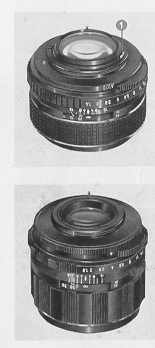 |
With the new SMC Takumar lenses with the diaphragm coupling lever (1), mounted directly on the ES II camera body, the TTL meter reads exposure through
the full-open aperture for correct automatic exposure. For open-aperture reading, the stop-down lever should be DOWN.
With all other lenses, or when using Extension Tubes, Bellows Unit or Microscope adapter,
remember always to push up the stop-down lever for stopped-down aperture reading and correct automatic exposure.
The SMC Takumar
85mm f/1.9 (bottom, left) and SMC TakumarZoom 85mm-2lOmm lenses do not have the diaphragm coupling lever (1); therefore, they should be used on the ES II for stop-down reading.
CAUTION:
All SMC Takumar lenses up to 300mm except the above two are designed for open-aperture reading. When directly mounted on the ES II, they will give
correct exposure readings at full aperture. Do not try to take meter readings at stopped-down aperture, as this will indicate different shutter
speeds.
Also remember that the TTL metering does not work unless the shutter dial is set at “AUTOMATIC”.
|

DEPTH-OF-FIELD PREVIEW LEVER
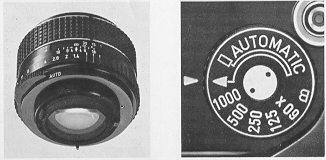 |
The preview lever on the lens should always be set to “AUTO” when the lens is used on the ES II. The lever has an interlock that prevents it from being
set to “MAN” when mounted on the ES II. When mounted on a Pentax camera other than the ES or ES II, the lever will operate normally.
|
|
MECHANICAL SHUTTER
In addition to the electronic shutter for automatic exposure control, the ES II has a mechanical shutter for speeds: 1/60 X for electronic flash synchronization,
1/125, 1/250, 1/500, 1/1000 sec. plus B (Bulb).
To operate at any one of these speeds, just turn the shutter dial from “AUTOMATIC” to the desired speed setting. Now the electric circuit and TTL meter
circuit are off.
To make an exposure longer than 8 seconds, set the shutter dial at B. The shutter will stay open as long as you depress the shutter button. As you release
your finger from the shutter button, the shutter closes.
For extremely long exposures, set the shutter lock by moving the lever to the left while depressing the shutter button. Alternately, use a cable release with
a locking device.
|
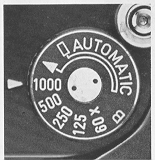 |
FILM
UNLOADING
|
After the final picture on the roll has been taken, the rapid wind lever will not turn, indicating that the film must be rewound.
|
Lift the rewind crank up. Depress the film rewind release button and turn the rewind crank as indicated to rewind the film into its cassette. Rewind
until the tension on the crank lessens, indicating that the leader end of the film has been released from the take-up spool.
|
Pull out the film rewind knob (the back will open automatically), and remove the film cassette.
AVOID DIRECT LIGHT WHEN LOADING OR UNLOADING THE FILM.
|
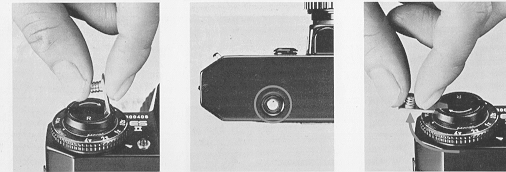 |
CAMERA HOLDING
As a general rule, your camera should be held more firmly by the left hand which does not release the shutter. If you hold your camera with the right hand - the
hand which releases the shutter — it may cause camera movement. Very often, blurred pictures are due to movement of the camera.
When you focus with the camera held horizontally (Position A), hold the lens barrel as illustrated. Cradle the camera with your left hand thumb and little
finger. Turn the focusing ring with your thumb and index finger. When holding the camera vertically, some people release the shutter with the thumb (Position
B), while others release it with the index finder (Position C). Position C is more desirable for fast focusing and shooting. With the Pentax, whether held
vertically or horizontally, you see your subject through the lens, enabling you to compose, focus and shoot with a minimum of time and effort.
|
Horizontal position A.
Hold the
camera firmly with your left hand, and draw your arms close to your body.
|
Vertical position B.
Hold your camera tightly to your forehead with your left hand, and draw your right arm close to your body.
|
Vertical position C.
Hold your camera tightly to your forehead with your left hand, raise your right arm and draw your left arm to your body.
|
 |
BATTERY INSERTION AND CHECK
Four 1.5V silver oxide batteries (Eveready S76E or Mallory MS-76H) power the TTL meter and electronic shutter of the ES II. The power
circuit is on only when you depress the shutter release button (lightly for meter reading and completely for electronic shutter) with the shutter speed dial
set at “AUTOMATIC”. When not operating the camera, be sure to keep the shutter dial off the “AUTOMATIC” settings, or use the shutter lock to prevent waste of
battery power when accidentally touching the shutter release button.
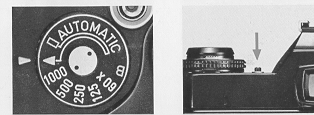 |
To insert the batteries, open the battery housing cover on the bottom of the lens mount by shifting the cover release pin (1) to the right with a matchstick or the like.
|
|
Insert four batteries, making sure that each battery correctly
faces the (+) (—) marks inside the housing. Close the cover by first inserting the two hooks (2) into the grooves. Push the battery housing lock pin (3) in.
One set of batteries lasts about one year. To check the life, set the shutter dial at “AUTOMATIC”, and while
looking through the viewfinder, push the battery check button next to the exposure factor control dial. If the meter needle drops to the center notch, the
batteries have sufficient capacity. If it does not, replace all four batteries.
|
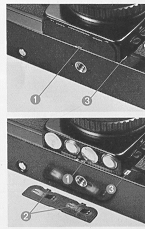 |
SELF-TIMER
The self-timer of the ES Il releases the shutter after 5 — 11
seconds, depending upon how far anti-clockwise you turn the winding lever. When
using the self-timer, do not depress the shutter release button . . it will
immediately release the shutter without delayed action.
 |
Turn the winding lever
down 90 degrees - 180 degrees. Move the self-timer start lever as indicated . . - the self-timer will start operating.
|
This self-timer has a unique interrupt function. Even after the self-timer has started to run, you can stop it by moving the start lever back to normal
position as long as the winding lever is between 180 and 90
You can re-start the self-timer by turning the winding lever down again and moving the start lever over.
Do not leave the winding lever in “interrupt” position for an extended period, as this may damage the spring.
Caution: Do not throw a
dead battery into fire, as it may explode. Also, keep it beyond the reach of small children.
FLASH SYNCHRONIZATION
The Pentax ES II has FP and X terminals at the front of the camera body, and an additional X contact in the hot shoe atop the pentaprism housing. As indicated in the table, set the shutter
dial at 1/60 X for electronic flash, with the flash cord plugged into the X terminal. Set the shutter dial at 1/60 or faster for FP class flash bulbs, with
the cord plugged into the FP terminal.

Use the hot shoe flash contact when using a shoe-mount electronic flash like a Honeywell Auto Strobonar with a flash contact on the
foot. In this case, there is no need to plug the flash cord into the X terminal on the body front.
The hot shoe flash contact turns to “hot” (switched on) only when you insert a shoe-mount electronic flash. It remains “cold” (disconnected) even when using an electronic flash with its cord
plugged into the X terminal on the body front. This eliminates the danger of electric shocks.
|
 |
When not using these terminals, keep the plugs inserted.
|
 |
DEPTH-OF-FIELD GUIDE
|
Depth of field is the range between the nearest and farthest distances which are in focus at a given lens aperture.
If you want to know how great the depth of field is at a certain aperture, look at the depth-of-field guide. In
the photograph below, the distance scale is set at 5 meters. . . the lens is focused on a subject 5 meters away. The calibrations on each side of the
distance index correspond to the diaphragm setting and indicate the range of in-focus distance for different lens apertures. For example, if the lens opening
of ff4 is to be used, the range on the distance scale ring covered within the figure 4 on the depth-of-field guide indicates the area in focus at that lens
opening. You will note from the depth-of-field guide in the photograph that the range from approximately 4.5 to 6.5m is in focus. Note that as the lens
apertures change, the effective depth of field also changes. For the depth of fields at different apertures and distances, refer to the next page.
|
|
 |
 |
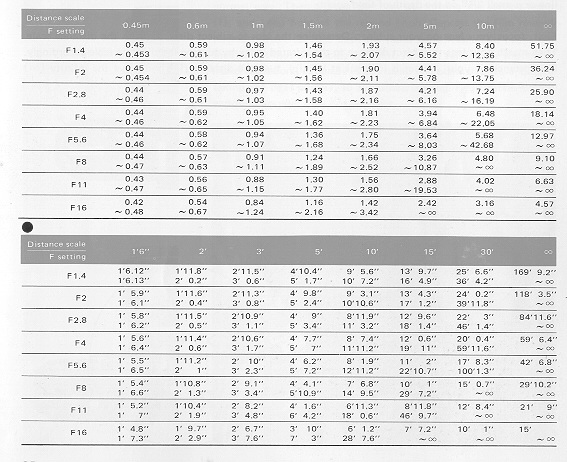
INFRA-RED PHOTOGRAPHY
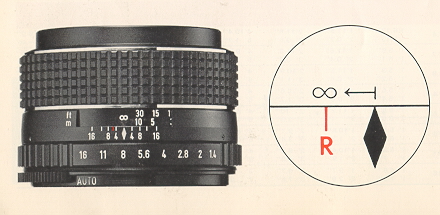 |
If you intend to take infra-red photographs, remember to use the infra-red index marked with an orange line or a small “R” on the depth-of-field guide. First, focus your
lens on your subject. Determine the lens-to-subject distance from the distance scale. Then match your lens-to-subject distance to the infrared
index by turning the distance scale accordingly. For instance, if your subject is in focus at infinity, turn the distance ring and move the
infinity (00) mark to the index.
|
MULTIPLE EXPOSURE
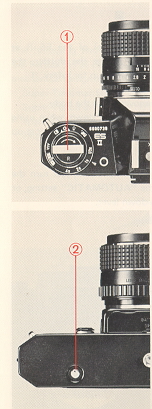 |
For deliberate multiple exposures, make the first exposure in the normal way. Then tighten the film by turning the rewind knob (1), and keep hold of the rewind knob.
Depress the film rewind release button (2) and wind the rapid wind lever, This winds the shutter without advancing the film. Finally, release the
shutter to make the second exposure. Then make one blank exposure, before taking the next picture, to avoid overlapping. Registration of the exposure
counter may not be exact.
|
 |
IMPORTANT NOTES
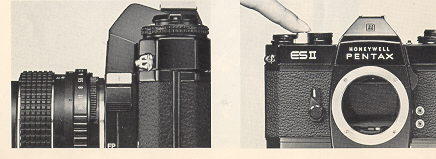 |
Always keep the stop-down lever down for open-aperture reading. Also, be sure to keep it down when interchanging
lenses; otherwise, the automatic diaphragm pin of the lens will hit the diaphragm activating lever in the body. Move it up only when checking the
depth of field or using stop-down metering lenses or Extension Tubes, Bellows Unit, etc. inserted between the lens and the camera body.
|
|
If you set the shutter dial of the ES II at “AUTOMATIC” and release the shutter, the reflex mirror will be locked up for safety, if
1) the lens cap is on.
2) the lens is removed from the body.
3) the stop-down lever is down, when using stop-down metering lenses or
close-up accessories.
To bring the reflex mirror down, just turn the shutter dial off the “AUTOMATIC” setting, or move up the stop-down lever.
|
|
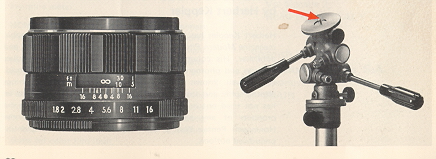 |
|
The following two lenses will not properly fit the Pentax ES II camera body due to different mechanical design and construction:
Super-Takumar 50mm f/1 .4
Super-Takumar 55mm f/1.8 (with “1 .8” engraved at the left end of the diaphragm ring and “16” at the right.)
|
The length of a tripod's
screw should not exceed the normal length of 4.5mm (3/16”). Do not extend it longer than this length when mounting your camera on a tripod. Forcing
longer screws into the tripod receptacle of the camera will damage the mechanism.
|
SPECIAL CAUTION:
Takumar lenses and Pentax accessories are engineered and meticulously produced for Pentax use. Use of other brands may cause difficulties
with the Pentax, for which we cannot assume any liability.
GUIDE BOOK FOR HONEYWELL PENTAX SYSTEM OF PHOTOGRAPHY
The operating manual for the
Honeywell Pentax cameras is merely an instruction book for the proper care and operation of the Honeywell Pentax cameras. It does not, and can not, deal fully
with every possible application of the Honeywell Pentax System of Photography because those applications are almost limitless.
The following book is therefore
recommended to those amateurs who are eager to learn more about the Honeywell Pentax System of Photography and photographic technique in general. It is
available in English, German, Italian and Spanish languages, and each can be obtained from your photo dealers or directly from the publishers listed on the
next page.
“THE HONEYWELL PENTAX WAY”
by Herbert Keppler
Herbert Keppler has been
associated with the U.S. photographic magazine Modern Photography for over 1 5 years as its editor and publisher. His column devoted exclusively to
single-lens reflex cameras and photography is very famous throughout the world. He is well known for his objective outlook on all things photographic and for
his healthy mistrust of any theory that he has not tried out in practice. He has no interest in pushing the products of any particular manufacturer and brings to
the Honeywell Pentax Way a knowledgeable, independent and unprejudiced outlook.
This comprehensive book deals mainly with the following
subjects:
OPERATION AND TECHNIQUE:
action, aperture, artificial light, camera care, carrying, choosing films, close-ups, copying, depth of field, developers, exposure, exposure meter, films,
film speed, filters, flash, focal length, focusing, holding, lighting, loading, long-range work, monocular, multiple flash, perspective, printing, shooting,
slide projection, Spotmatic operation, storing negatives, telescope, tripod, unloading, viewing.
ACCESSORIES:
accessory clip, bellows unit, body cover, cable release, cassettes, close-up lenses, copying unit, exposure meters, extension tubes, focusing magnifier,
Leica adapter, lens cap, lenses, microscope adapter, prescription eyepiece, right-angle finder, slide copier, SPOT exposure meter.
HONEYWELL PENTAX SUBJECTS:
animals, architecture, birds, candid, cinema, fireworks, flowers, groups, lights, low light, nature, night, portraits, scenic, sports, television,
theater, travel, under water, wildlife.
FINDING DATA: close-up exposure, color temperature, depth of field, extension bellows, extension tubes,
feet-meter conversion, films, film speed conversion, filters, filter equivalent, filters for color film flash
WARRANTY POLICY
Your new Honeywell Pentax ES II is warranted for one year against defects in material or workmanship. This covers either the original
purchaser or the gift recipient. Any defect in your ES II will be repaired or replaced (at our option) and defective parts will be replaced without cost to
you within the 12-month period, provided the camera has not been abused, altered or operated contrary to instructions. Honeywell will not be liable for damages
from delay or loss of use or other indirect consequential damages.
If your camera should require service, you may send it to the most convenient factory center listed.
PENTAX INTER NATIONAL WARRANTY
If you intend taking your Pentax abroad during the warranty period, you may obtain a Honeywell Pentax international warranty card by writing
to us. With your request, include your name, address, camera and lens serial numbers, dealer's name and address, and proof of date purchased.
![]() ,
M. Butkus, NJ.
,
M. Butkus, NJ.
